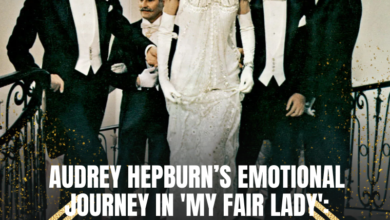Why David Lynch Believes Marilyn Monroe Is the Ultimate Muse Behind His ‘Lynchian’ World
OPINION: This article may contain commentary which reflects the author's opinion.
David Lynch is a director whose cinematic world is so distinctive that it has become its own term—“Lynchian.” This label refers to the surreal, dream-like atmosphere of his work, filled with psychological complexity, eerie beauty, and dark secrets lurking behind seemingly ordinary facades. Over time, countless filmmakers have drawn inspiration from his unique style, but Lynch’s fascination with one particular figure—Marilyn Monroe—has remained a central influence in his career. In many ways, Monroe’s enigmatic persona and complex life mirror the themes Lynch has explored throughout his films and television shows.
Monroe: The Icon and the Mystery
Marilyn Monroe, the epitome of Golden Age Hollywood glamour, is one of the most recognizable figures in cinematic history. Her face is iconic, her image a symbol of beauty and femininity. Yet, beneath the surface, Monroe’s life was far from the fairy-tale narrative the public often associated her with. She was more than just the ‘dumb blonde’ character she frequently portrayed on screen—she was a talented actress with impeccable comedic timing, a passionate reader with a library of over 400 books, and a woman who struggled with personal demons, including a traumatic childhood and ongoing mental health issues. Monroe’s public persona as the perfect, alluring starlet clashed with the reality of her complex inner life, making her a fascinating and tragic figure.
For Lynch, who is renowned for his fascination with characters who lead double lives or hide dark secrets, Monroe represented the perfect muse. “Everything is about Marilyn Monroe,” Lynch once said, encapsulating his lifelong obsession with the starlet. His admiration for her went beyond her beauty or fame—it was rooted in the mystery and complexity that surrounded her life.
The Lynchian Monroe: Laura Palmer and the Darker Side of Stardom
Lynch’s cinematic universe is filled with characters that embody the same dichotomy of light and dark that Monroe personified. One of the most significant ways Lynch incorporated Monroe’s influence into his work was through the character of Laura Palmer in Twin Peaks. Lynch himself once stated, “You could say that Laura Palmer is Marilyn Monroe.” On the surface, Laura is the quintessential small-town beauty—the girl next door with a sweet smile and a tiara, much like Monroe’s glamorous image. But, as with Monroe, there is more to Laura than meets the eye.
In Twin Peaks, Palmer’s mysterious death sets the stage for an unraveling story about secrets, trauma, and a hidden life that contradicts the public persona she once projected. Lynch’s slow reveal of Laura Palmer’s true story—a young woman with a dark, troubled past—mirrors the public’s perception of Monroe, who was often viewed as the “dumb blonde” but was, in fact, a deeply intelligent and sensitive person. Like Monroe, Laura’s complexity and contradictions make her a fascinating, tragic figure—someone who, on the surface, appears perfect but is burdened with layers of personal turmoil.
Lynch’s exploration of these complex women is not about fetishizing their struggles or glorifying their trauma. Instead, it’s about understanding the depths of human complexity and the mystery behind seemingly perfect figures. As Lynch explained, “It’s hard to say exactly what it is about Marilyn Monroe, but the woman-in-trouble thing is part of it.” Yet, he quickly clarifies, “It’s not just the woman-in-trouble thing that pulls you in, though. It’s more that some women are really mysterious.”
Mulholland Drive and the Continued Monroe Influence
Lynch’s 2001 film Mulholland Drive is another work where Monroe’s influence is apparent. The film features a woman with a dual identity, much like the duality of Monroe’s own public and private lives. In the world of Mulholland Drive, the dreamlike quality and the struggle for identity reflect Lynch’s ongoing exploration of mystery and the complexities of stardom. Like Laura Palmer, the characters in Mulholland Drive are beautiful and beguiling on the surface, yet their inner lives are filled with confusion, darkness, and secrets.
The parallel between Mulholland Drive and Monroe’s own struggles becomes clearer when considering Lynch’s obsession with uncovering the deeper layers of his characters. The characters in his works, like Monroe, are enigmatic figures who defy easy interpretation, and Lynch’s fascination lies in uncovering the contradictions within them.
Lynch’s Eternal Fascination with Monroe
Lynch’s love for Monroe and the characters who embody her complexities never waned. As he revisited Laura Palmer’s story in Twin Peaks and continued to explore the psychological landscapes of his characters in later projects, Lynch’s ongoing creative journey can be seen as an attempt to unravel the mystery of Monroe’s life and legacy. “I always loved Laura Palmer,” Lynch said in a 2014 interview, reflecting on his deep connection with the character. The more Lynch explored Laura’s life, the more he seemed to return to the central mystery of Monroe—how could someone so universally adored also harbor such darkness and pain?
In many ways, Lynch’s projects are an attempt to understand the allure of the tragic, complicated women like Monroe. They are not simply victims or symbols—they are living contradictions, beautiful and broken, light and dark. Lynch’s fascination with these women was never about their trauma for its own sake; it was about understanding the complexity and richness of their inner lives, which were often hidden behind the glossy veneer of Hollywood stardom.
Conclusion: Marilyn Monroe as the Ultimate Lynchian Muse
David Lynch’s cinematic world is a labyrinth of contradictions, and at the heart of his fascination lies Marilyn Monroe, a woman who embodied the tension between public perfection and private pain. For Lynch, Monroe is more than just a Hollywood icon—she is a symbol of the mysterious, multi-dimensional women who populate his films. From Laura Palmer to Mulholland Drive, Lynch’s work continues to be haunted by the essence of Monroe: beautiful, troubled, and eternally enigmatic. Monroe may have lived in the spotlight, but it is in the shadows of her life, her complexity, and her contradictions that Lynch finds the ultimate muse.



